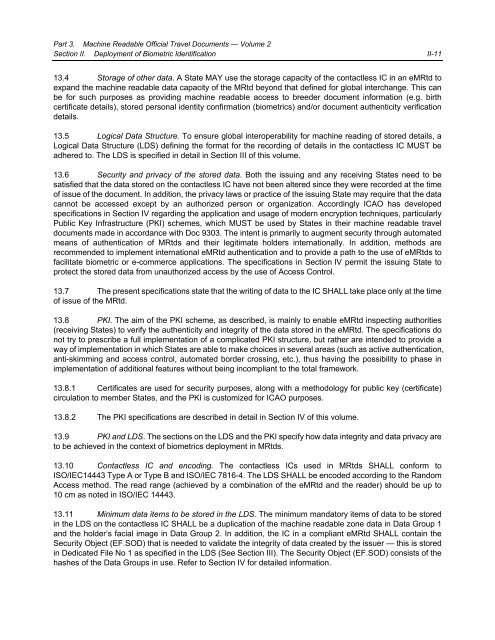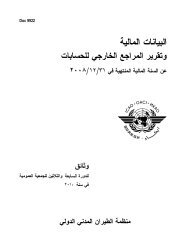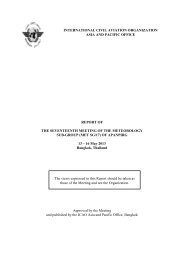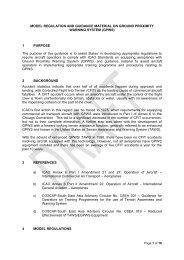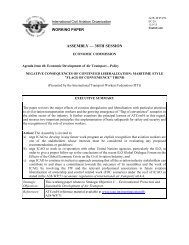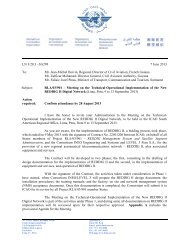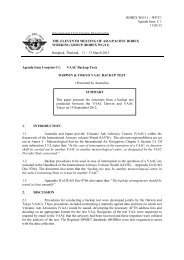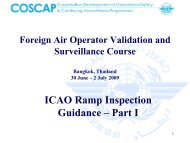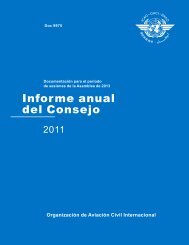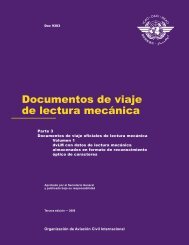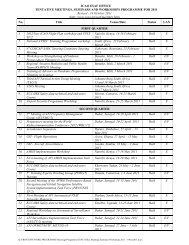Machine Readable Travel Documents - ICAO
Machine Readable Travel Documents - ICAO
Machine Readable Travel Documents - ICAO
You also want an ePaper? Increase the reach of your titles
YUMPU automatically turns print PDFs into web optimized ePapers that Google loves.
Part 3. <strong>Machine</strong> <strong>Readable</strong> Official <strong>Travel</strong> <strong>Documents</strong> — Volume 2<br />
Section II. Deployment of Biometric Identification II-11<br />
13.4 Storage of other data. A State MAY use the storage capacity of the contactless IC in an eMRtd to<br />
expand the machine readable data capacity of the MRtd beyond that defined for global interchange. This can<br />
be for such purposes as providing machine readable access to breeder document information (e.g. birth<br />
certificate details), stored personal identity confirmation (biometrics) and/or document authenticity verification<br />
details.<br />
13.5 Logical Data Structure. To ensure global interoperability for machine reading of stored details, a<br />
Logical Data Structure (LDS) defining the format for the recording of details in the contactless IC MUST be<br />
adhered to. The LDS is specified in detail in Section III of this volume.<br />
13.6 Security and privacy of the stored data. Both the issuing and any receiving States need to be<br />
satisfied that the data stored on the contactless IC have not been altered since they were recorded at the time<br />
of issue of the document. In addition, the privacy laws or practice of the issuing State may require that the data<br />
cannot be accessed except by an authorized person or organization. Accordingly <strong>ICAO</strong> has developed<br />
specifications in Section IV regarding the application and usage of modern encryption techniques, particularly<br />
Public Key Infrastructure (PKI) schemes, which MUST be used by States in their machine readable travel<br />
documents made in accordance with Doc 9303. The intent is primarily to augment security through automated<br />
means of authentication of MRtds and their legitimate holders internationally. In addition, methods are<br />
recommended to implement international eMRtd authentication and to provide a path to the use of eMRtds to<br />
facilitate biometric or e-commerce applications. The specifications in Section IV permit the issuing State to<br />
protect the stored data from unauthorized access by the use of Access Control.<br />
13.7 The present specifications state that the writing of data to the IC SHALL take place only at the time<br />
of issue of the MRtd.<br />
13.8 PKI. The aim of the PKI scheme, as described, is mainly to enable eMRtd inspecting authorities<br />
(receiving States) to verify the authenticity and integrity of the data stored in the eMRtd. The specifications do<br />
not try to prescribe a full implementation of a complicated PKI structure, but rather are intended to provide a<br />
way of implementation in which States are able to make choices in several areas (such as active authentication,<br />
anti-skimming and access control, automated border crossing, etc.), thus having the possibility to phase in<br />
implementation of additional features without being incompliant to the total framework.<br />
13.8.1 Certificates are used for security purposes, along with a methodology for public key (certificate)<br />
circulation to member States, and the PKI is customized for <strong>ICAO</strong> purposes.<br />
13.8.2 The PKI specifications are described in detail in Section IV of this volume.<br />
13.9 PKI and LDS. The sections on the LDS and the PKI specify how data integrity and data privacy are<br />
to be achieved in the context of biometrics deployment in MRtds.<br />
13.10 Contactless IC and encoding. The contactless ICs used in MRtds SHALL conform to<br />
ISO/IEC14443 Type A or Type B and ISO/IEC 7816-4. The LDS SHALL be encoded according to the Random<br />
Access method. The read range (achieved by a combination of the eMRtd and the reader) should be up to<br />
10 cm as noted in ISO/IEC 14443.<br />
13.11 Minimum data items to be stored in the LDS. The minimum mandatory items of data to be stored<br />
in the LDS on the contactless IC SHALL be a duplication of the machine readable zone data in Data Group 1<br />
and the holder’s facial image in Data Group 2. In addition, the IC in a compliant eMRtd SHALL contain the<br />
Security Object (EF.SOD) that is needed to validate the integrity of data created by the issuer — this is stored<br />
in Dedicated File No 1 as specified in the LDS (See Section III). The Security Object (EF.SOD) consists of the<br />
hashes of the Data Groups in use. Refer to Section IV for detailed information.


